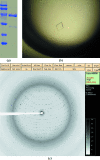Preliminary X-ray crystallographic studies of mouse UPR responsive protein P58(IPK) TPR fragment
- PMID: 18259061
- PMCID: PMC2374174
- DOI: 10.1107/S1744309108000833
Preliminary X-ray crystallographic studies of mouse UPR responsive protein P58(IPK) TPR fragment
Abstract
Endoplasmic reticulum (ER) stress induces the unfolded protein response (UPR), which can promote protein folding and misfolded protein degradation and attenuate protein translation and protein translocation into the ER. P58(IPK) has been proposed to function as a molecular chaperone to maintain protein-folding homeostasis in the ER under normal and stressed conditions. P58(IPK) contains nine TPR motifs and a C-terminal J-domain within its primary sequence. To investigate the mechanism by which P58(IPK) functions to promote protein folding within the ER, a P58(IPK) TPR fragment without the C-terminal J-domain was crystallized. The crystals diffract to 2.5 A resolution using a synchrotron X-ray source. The crystals belong to space group P2(1), with unit-cell parameters a = 83.53, b = 92.75, c = 84.32 A, alpha = 90.00, beta = 119.36, gamma = 90.00 degrees. There are two P58(IPK) molecules in the asymmetric unit, which corresponds to a solvent content of approximately 60%. Structure determination by MAD methods is under way.
Figures

References
Publication types
MeSH terms
Substances
Grants and funding
LinkOut - more resources
Full Text Sources

